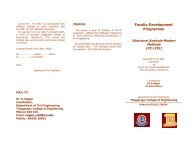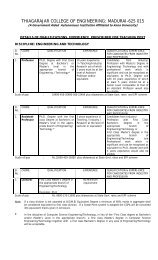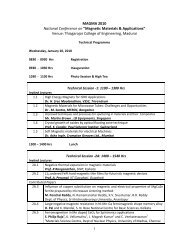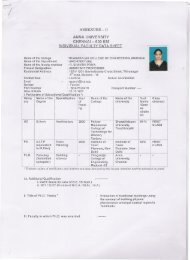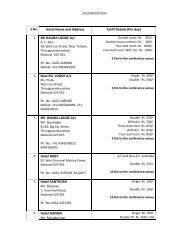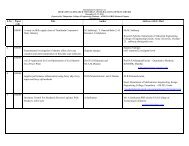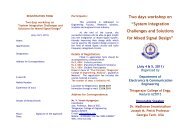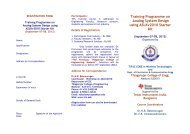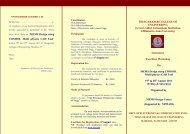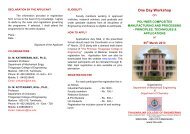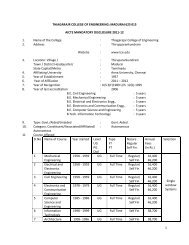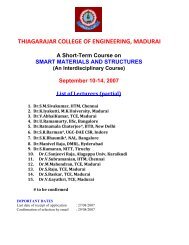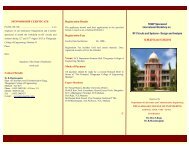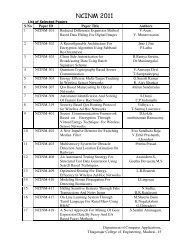THIAGARAJAR COLLEGE OF ENGINEERING: MADURAI – 625 015 ...
THIAGARAJAR COLLEGE OF ENGINEERING: MADURAI – 625 015 ...
THIAGARAJAR COLLEGE OF ENGINEERING: MADURAI – 625 015 ...
- TAGS
- thiagarajar
- college
- madurai
- tce.edu
You also want an ePaper? Increase the reach of your titles
YUMPU automatically turns print PDFs into web optimized ePapers that Google loves.
Unit I: Operational Amplifier Introduction: Introduction to linear integrated circuits <strong>–</strong> Types<br />
-developments of ICs <strong>–</strong> Basic information of op-amp -- DC Characteristics <strong>–</strong> Input offset voltage <strong>–</strong> Input<br />
bias circuit <strong>–</strong> Input offset current <strong>–</strong> Thermal drift <strong>–</strong>AC Characteristics - Frequency response <strong>–</strong> Stability.<br />
(10<br />
Periods)<br />
Unit II: Operational Amplifier Specifications: Definition of terms : Input resistance, unity <strong>–</strong> Gain B.W,<br />
large signal voltage gain, input offset voltage, input bios current, input offset current, CMRR, output<br />
voltage swing, slew <strong>–</strong> rate, power B.W, use of manufactures data sheets for various op-amps. Exact and<br />
approximate output voltage due to VI0, IB and Iios, Use of compensating resister to minimize output<br />
voltage. Input resistance for inverting, non- inverting and source follower circuits.<br />
(10 Periods)<br />
Unit III: Op-amp applications: Summer <strong>–</strong> Subtractor <strong>–</strong> adder and subtractor <strong>–</strong> Instrumentation amplifier <strong>–</strong><br />
AC amplifier- DC amplifier <strong>–</strong> V to I and I to V converters - Op-Amp circuits using diodes <strong>–</strong> sample and<br />
hold circuit <strong>–</strong> log and antilog amplifiers- Multipliers and dividers <strong>–</strong> Differentiator and integrator.<br />
(10 Periods)<br />
Unit IV: Comparator, Voltage Regulators and 555 Timer: Comparator <strong>–</strong> Regenerative comparator <strong>–</strong><br />
Square wave generator <strong>–</strong>Monostable Multivibrator- Triangular wave generator - Sine wave generator <strong>–</strong><br />
Regulators <strong>–</strong> Series op-amp regulator- IC voltage regulator -723 General Purpose regulator <strong>–</strong> Switching<br />
regulator - 555 Timer - functional diagram <strong>–</strong> Monostable and Astable operation <strong>–</strong> Schmitt trigger.<br />
(10 Periods)<br />
Unit V: DAC, PLL and Filters: PLL- Principle of PLL <strong>–</strong>Phase detector <strong>–</strong> VCO <strong>–</strong> Monolithic PLL- PLL<br />
applications <strong>–</strong> Basic DAC techniques <strong>–</strong> DAC/ADC specifications <strong>–</strong> Review of filter basics <strong>–</strong> Order of<br />
response and number poles concept <strong>–</strong> Advantages of and limitations of active filters <strong>–</strong> One op-amp<br />
realization of single pole LP, HP, Switched capacitor filter.<br />
(10 Periods)<br />
Text books:<br />
1. Stanley, “Operation Amplifiers with Linear Integrated Circuits”, 4 th Edition, Prentice Hall, 2002<br />
2. D.Roy Choudhury and Shail Jain, “Linear Integrated Circuits” New Age international (P) Ltd.<br />
1998.<br />
Reference Books:<br />
1. Ramakant A. Gayakwad, “Op- Amps and linear integrated Circuits”, Prentice Hall of India, 1997.<br />
2. Jacob, “Applications & Design with Analog Integrated Circuits”, Reston Publications,1999<br />
D34 NETWORK ANALYSIS AND SYNTHESIS<br />
Unit <strong>–</strong> I: Network Analysis: Terminal ports <strong>–</strong> Network functions for one part and two port- Ladder<br />
network <strong>–</strong> General networks <strong>–</strong> Poles and zeros of network functions- Restrictions on pole and zero<br />
Locations for driving point functions and transfer functions <strong>–</strong> Time domain behavior from the poles and<br />
zero plot <strong>–</strong> Stability of active networks. (10 Periods)<br />
Unit <strong>–</strong> II: Two Port Parameters: Relationship of two port variables <strong>–</strong> Open circuit impedance parameters,<br />
short circuit admittance parameters <strong>–</strong> Transmission (ABCD) parameters <strong>–</strong> Hybrid (h) parameters <strong>–</strong> Inverse<br />
hybrid (h) and transmission parameters <strong>–</strong> Relationships between parameters sets parallel connection of two



